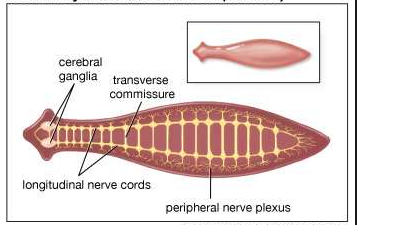

Characters | Turbellaria | Trematoda (Flukeworms) | Cestoda (Tapeworms) |
|---|---|---|---|
Mode of Life | Free-living | Parasitic | Exclusively endoparasitic |
Alimentary canal | Incomplete - Without Anus (Pharynx is present in Planaria which is protrusible/ everted) | Incomplete - Without Anus | Absent |
Cilia | Body is ciliated and Mucus-secreting gland | Body is not ciliated | Body is not ciliated |
Body structure | Unsegmented leaf like | Unsegmented leaf like | Segmented ribbon/ tape like |
Adhesive organs | No hooks nor sucker |
|
|
Receptors |
| X | X |
Development | Direct |
|
|
Examples |
|
|
|



Male Reproductive Organs | Female Reproductive Organs |
|---|---|
1 pair of testes
| Single ovary
|
Cirrus (Muscular penis) Act as Male copulatory organ | Laurer’s canal Act as Temporary vagina (Appears only during Breeding season) |
Genital pore/ Gonopore (Located between the two suckers) | |
Vitelline glands
Mehlis gland/ Shell gland
|



14117-7/asset/2da22471-b2eb-44de-8ab8-ba4e5b402379/main.assets/gr1_lrg.jpg?t=1758707645633)
S.N. | Taenia solium (Pork tapeworm) | Taenia saginata (Beef tapeworm) | Echinococcus granulosa (Dog tapeworm/ Hydatid worm) | Diphylobothrium latum (Fish tapeworm) | Hymenolepsis nana (Dwarf tapeworm) |
|---|---|---|---|---|---|
Unique | Longest tapeworm in human | Shortest tapeworm in human | |||
1. Residence of Adult tapeworm | Small intestine of human | Small intestine of human | Small intestine of dog, wolf, jackal, hyena, fox | ||
2. Residence of Larva | Muscles of Pig/ Brain or Eye muscles of human | Muscles of cow or buffalo | Liver/ Lungs/ Muscles of sheep/ human | ||
3. Primary host/ Definite host | Human | Human | Canine animals like dog, wolf, jackal, etc. | • Trigenetic | Human |
A) Human | |||||
4. Secondary host | Pig | Cow/ Buffalo | Sheep/ Human/ Cattle | B) Fish | The life cycle is simple without any intermediate host but flour beetles and fleas may serve as the intermediate host. |
C) Cyclops | |||||
6. Size | 2-3 meter | 5-8 meter | 4-6 millimeter | ||
5. Human acts as | Definitive + Intermediate host | Definite host | Intermediate host | ||
7. Scolex | - Presence of Rostellum with hooks + hooklets | - Absent | - Absent | ||
- Suckers present | - Present | - Present | |||
8. No. of proglottids | 900-1000 | 1800-2000 | 3 or 4 | ||
- Immature = 1 | |||||
- Mature = 1 | |||||
- Gravid = 1 or 2 | |||||
9. Mode of Transmission | - By measly meat of pig; | By meat of cow/ buffalo | - By contaminated food/ water; | ||
- By contaminated water/ food (Cystericercosis) | - By direct contact with infected dogs | ||||
10. Infective stage | Cystercercus cellulosae | Cystercercus bovis | Hydatid cyst (Hexacanth larva) | ||
11. Diseases | - Adult = Taeniasis | - Adult = Taeniasis | - Adult = ……… | ||
- Larva = Cystercercosis | - Larva = …… | - Larva = Hydatid disease/ Echinococcosis | |||
12. Eggs | Are infective | Not infective | Are infective | ||
13. Susceptibility | Both vegetarians and Non-vegetarians are affected | Only non-vegetarians are affected | All (Including those in contact with dogs are affected |